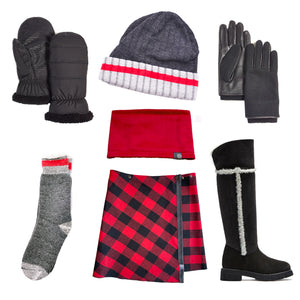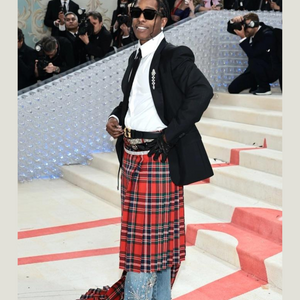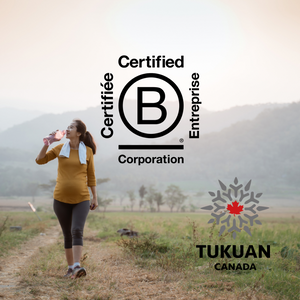Eco-responsible fabric choices for TUKUAN
Fabric, which is the foundation of all garments, must be grown (or manufactured in a factory), processed into thread, and woven, all before it reaches the designers hands where creativity and creation comes into play. Silhouette, vibe and mood are all translated through the language of the fabric.
At TUKUAN, we are always looking for more eco-responsible options at all levels of the company. We are considering offering more overskirts made from recycled and/or sustainable materials.
Here’s a list of three fabrics that we want to include in the manufacturing of our garments because they are considered eco-friendly and also sustainable in how they are grown and processed. The idea is to understand what is an eco-friendly fabric in order to make better consumer choices that are right for our health, the environment and animals.
Organic wool:
In Canada, for wool to be certified organic, it must adhere to the same rigorous requirements as organic meat. Sheep must be fed organic food and cannot be injected with growth hormones; plus, among other restrictions, fleeces cannot be washed in chemicals. Not only is organic wool better for the sheep, it could be better for your skin. a lot of people aren't actually allergic to wool - they're allergic to the chemicals and dyes that go into processing it.
Even the farming space for managing organic livestock is very different from mass farming operations. Farmers cannot exceed the natural carrying capacity of the land on which the sheep graze, says the Organic Trade Association, because overgrazing contributes to land becoming unsustainable.
Thus, according to the Organic Trade association, for wool to be certified as organic in the United States, it must be produced in accordance with federal standards for organic livestock production as described the U.S. Department of Agriculture’s National Organic Standards. These include:
-
Use of genetic engineering is prohibited;
-
All livestock feed, forage and bedding (if roughage) used from the last third of gestation must be certified organic (including pasture);
-
All organic sheep must have year-round access to the outdoors and obtain a minimum of 30% of their dry matter intake from pastures for a minimum of 120 days to ensure grazing is a substantive portion of the animal’s diet;
-
Use of conventional synthetic hormones, medicines, and synthetic pesticides (internal, external, and on pastures, including organophosphates, amidines, and synthetic pyrethroids2), is prohibited. Only those “least toxic” materials on the National List of Allowed and Prohibited Substance as found in the organic regulations (section 205.603) may be used;
-
Producers must encourage livestock health through preventive disease management practices prior to the use of approved synthetic medicines.
-
The processing of raw organic wool into finished products is addressed by the voluntary Global Organic Textile Standard (GOTS). GOTS requires a minimum of 70% organic fiber (in this case wool), prohibits the use of toxic processing inputs – including dyes and chlorine-based pre-treatments for scouring and descaling (for machine washability) – and requires the treatment of wastewater discharged from cleaning, dyeing and other wool processing stages. As with organic fiber certification, such processing is verified by a third- party independent certification organization.
-
In the last 10 years, the textile industry, along with animal ethics groups like People for the Ethical Treatment of Animals, have lobbied against the wool industry, taking a stand against unethical treatment of sheep. In 2004, U.S. retailer Abercrombie and Fitch became the first to sign on to an animal rights campaign boycott of Australian wool that stood firmly against the typical practices of mulesing (where folds of skin around the sheep’s anus are cut off with shears during the wool shearing) and live export of sheep to halal butchers when their wool production becomes minimal. Other companies have since joined, sourcing wool from South Africa or South America (where mulesing is not done). The result of this outcry has led to the increased production of both organic and ethical wool, though it is still relatively minor when compared to the overall global wool production.
-
To complicate things a bit more, each country maintains their own standards for “organic wool” – Australia, for instance, has no equivalence or agreement with US organic standards. The International Wool Textile Organization (IWTO) has adopted a new organic wool standard (closely aligned with GOTS) which they hope will be accepted by its members. In addition, many companies use the term “eco wool”, which means the wool is sheared from free range roaming sheep that have not been subjected to toxic flea dipping, and the fleece was not treated with chemicals, dyes or bleaches – but this is wide open to interpretation and exploitation of that term. According to the IWTO, “Eco wool” must meet the standards set by the EU Eco-label. (https://oecotextiles.wordpress.com/2009/08/11/what-does-organic-wool-mean/)
Organic cotton:
Cotton fabric is made from natural plant fibers and is widely used in clothes and table linens and everything from delicate baby onesies to denim blue jeans. The fibers can be woven or knit to produce comfortable, breathable fabrics. According to the website aboutorganiccotton.org, organic cotton is ‘produced and certified to organic agricultural standards.’ In other words, the production of this type of cotton adds to the health of soil, ecosystems, and people, rather than hindering it. Free from toxic chemicals, pesticides, and GMOs (genetically modified organisms,) organic cotton farming utilizes natural processes.
There are various ways in which brands can prove that the raw materials they are sourcing are organic, one of them being the use of the Global Organic Textile Standard (GOTS) certification. GOTS uses ecological and social criteria to create a standard for organic cotton supply chains. This crop means higher standards, though it also means ultra-soft fabric.
The website for the Sustainable Cotton Project says 10% of all agricultural pesticides produced worldwide are used on cotton. So by purchasing organic cotton, you're sending a strong message about the use of pesticides on plants.

Recycled polyester:
Nearly half of the world’s clothing is made of polyester and Greenpeace forecasts this amount to nearly double by 2030. Why? The athleisure trend if one of the main reasons behind it: an increasing number of consumers are look for stretchier, more resistant garments. The problem is, polyester is not a sustainable textile option, as it is made from polyethylene terephthalate (PET), the most common type of plastic in the world. In short, the majority of our clothes come from crude oil.
One year ago, the non-profit organization Textile Exchange challenged over 50 textile, apparel and retail companies (including giants like Adidas, H&M, Gap and Ikea) to increase their use of recycled polyester by 25 percent by 2020. It worked: last month, the organization issued a statement celebrating that signatories have not only met the goal two years before the deadline, they have actually exceeded it by upping their use of recycled polyester by 36 percent. In addition, twelve more companies have pledged to join the challenge this year. The organization forecasts 20% of all polyester to be recycled by 2030.
Recycled polyester, also known as rPET, is obtained by melting down existing plastic and re-spinning it into new polyester fiber. While much attention is given to rPET made from plastic bottles and containers thrown away by consumers, in reality polyethylene terephthalate can be recycled from both post-industrial and post-consumer input materials. But, just to give an example, five soda bottles yield enough fiber for one extra-large T-shirt.
Although recycling plastic sounds like an indisputable good idea, rPET’s celebration is far from being a unanimity in the sustainable fashion community. FashionUnited has gathered the main arguments from both sides.
Recycled polyester: the pros
1. Keeping plastics from going to landfill and the ocean - Recycled polyester gives a second life to a material that’s not biodegradable and would otherwise end up in landfill or the ocean.
2. rPET is just as good as virgin polyester, but takes less resources to make - Recycled polyester is almost the same as virgin polyester in terms of quality, but its production requires 59% less energy compared to virgin polyester, according to a 2017 study by the Swiss Federal Office for the Environment.
Recycled polyester: the cons
1. Recycling has its limitations - Many garments are not made from polyester alone, but rather from a blend of polyester and other materials. In that case, it is more difficult, if not impossible, to recycle them. Also, certain laminations and finishings applied to the fabrics can also render them un-recyclable.
Even clothes that are 100% polyester can’t be recycled forever. “through mechanical recycling, the fibre can lose its strength and thus needs to be mixed with virgin fibre,” notes the Swiss Federal Office for the Environment.
Ultimately, the main concern is that if the public believes everything they throw away can be recycled, they will probably see no problem in continuing to consume disposable plastic goods. Unfortunately, only a small portion of the plastic we use gets recycled. Shoppers should be encouraged to favor natural fibers as much as possible. After all, even though rPET takes 59% less energy to produce than virgin polyester, it still requires more energy than hemp, wool and both organic and regular cotton, according to a 2010 report from the Stockholm Environment Institute.
https://fashionunited.uk/news/fashion/how-sustainable-is-recycled-polyester/2018111540000





